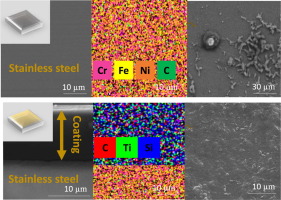当前位置:
X-MOL 学术
›
Bioelectrochemistry
›
论文详情
Our official English website, www.x-mol.net, welcomes your feedback! (Note: you will need to create a separate account there.)
Microbiologically influenced corrosion mechanism of 304L stainless steel in treated urban wastewater and protective effect of silane-TiO2 coating.
Bioelectrochemistry ( IF 5 ) Pub Date : 2019-11-21 , DOI: 10.1016/j.bioelechem.2019.107413 I Ziadi 1 , M M Alves 2 , M Taryba 2 , L El-Bassi 3 , H Hassairi 3 , L Bousselmi 3 , M F Montemor 2 , H Akrout 3
Bioelectrochemistry ( IF 5 ) Pub Date : 2019-11-21 , DOI: 10.1016/j.bioelechem.2019.107413 I Ziadi 1 , M M Alves 2 , M Taryba 2 , L El-Bassi 3 , H Hassairi 3 , L Bousselmi 3 , M F Montemor 2 , H Akrout 3
Affiliation

|
Microbiologically influenced corrosion (MIC) of bare and silane-TiO2 sol-gel coated stainless steel (SS) was studied in treated urban wastewater (TUWW). Combining the electrochemical impedance spectroscopy (EIS) and the scanning vibrating electrode technique (SVET) showed that SS surface colonization occurs, at earlier stages, by iron-oxidizing bacteria (IOB), and later by sulphate-reducing bacteria (SRB). The SVET results showed that chemical corrosion process and bacterial respiration led to the depletion of dissolved oxygen, creating a differential aeration cell and thus a localized corrosion phenomenon. Scanning electron microscopy (SEM) and energy dispersive spectroscopy (EDS) showed that the growth of a bacterial biofilm on 304L SS was a dynamic process, stimulating the localized oxidation of SS. To improve corrosion protection, a silane-TiO2 sol-gel coating for SS is proposed. SEM showed that the coating reduced bacterial adhesion and EIS study demonstrated that the coating improved the barrier properties and corrosion resistance of 304L SS in TUWW over a short period of immersion.
中文翻译:

微生物对304L不锈钢在城市污水中的腐蚀机理及硅烷-TiO2涂层的保护作用
研究了城市污水(TUWW)中裸露和硅烷-TiO2溶胶-凝胶涂层不锈钢(SS)的微生物学腐蚀(MIC)。电化学阻抗谱(EIS)和扫描振动电极技术(SVET)的结合表明,SS表面定殖在较早阶段通过氧化铁细菌(IOB)发生,随后通过硫酸盐还原细菌(SRB)发生。SVET结果表明,化学腐蚀过程和细菌呼吸导致溶解氧耗竭,从而形成差分曝气池,从而产生局部腐蚀现象。扫描电子显微镜(SEM)和能量色散谱(EDS)表明,细菌生物膜在304L SS上的生长是一个动态过程,刺激了SS的局部氧化。为了改善腐蚀防护,提出了一种用于SS的硅烷-TiO2溶胶-凝胶涂料。SEM表明该涂层降低了细菌的附着力,EIS研究表明该涂层在短时间内浸没后改善了TUWW中304L SS的阻隔性能和耐腐蚀性。
更新日期:2019-11-22
中文翻译:

微生物对304L不锈钢在城市污水中的腐蚀机理及硅烷-TiO2涂层的保护作用
研究了城市污水(TUWW)中裸露和硅烷-TiO2溶胶-凝胶涂层不锈钢(SS)的微生物学腐蚀(MIC)。电化学阻抗谱(EIS)和扫描振动电极技术(SVET)的结合表明,SS表面定殖在较早阶段通过氧化铁细菌(IOB)发生,随后通过硫酸盐还原细菌(SRB)发生。SVET结果表明,化学腐蚀过程和细菌呼吸导致溶解氧耗竭,从而形成差分曝气池,从而产生局部腐蚀现象。扫描电子显微镜(SEM)和能量色散谱(EDS)表明,细菌生物膜在304L SS上的生长是一个动态过程,刺激了SS的局部氧化。为了改善腐蚀防护,提出了一种用于SS的硅烷-TiO2溶胶-凝胶涂料。SEM表明该涂层降低了细菌的附着力,EIS研究表明该涂层在短时间内浸没后改善了TUWW中304L SS的阻隔性能和耐腐蚀性。


























 京公网安备 11010802027423号
京公网安备 11010802027423号